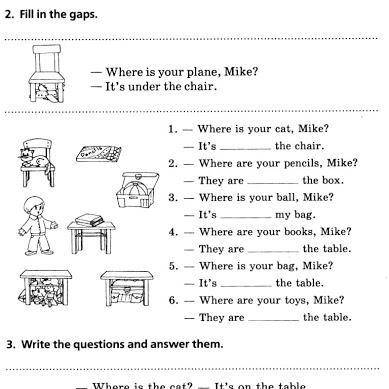1. - Where is your cat, Mike? - It's the chair.
2. - Where are your pencils, Mike? are
They
- 3. – Where is your ball, Mike?
the box.
- It's my bag.
4.- Where are your books, Mike? They are the table.
5. Where is your bag, Mike?
- It's the table. 6. Where are your toys, Mike?
- They are

Другие вопросы по теме Английский язык
Популярные вопросы
- Поміркуйте, які факти з громадянсько-політичного життя галичини викликали такі...
2 - Как вы думаете труд это право или обязаности гражданина...
1 - Докажите тождество [tex]4x^{2} -4xy+2y^{2} +12y+37\ \textgreater \ 0[/tex]...
2 - изложить свой мнения на сказку заяц коротко изложить мнения...
3 - Какое будет продолжение предложений в по языку? finish the sentences. remember...
2 - Установите графически, пересекаются ли графики функций( 20 )у = х и: 2) y = 0,3х...
2 - Напишите сочинение на тему семьи,используя эти фразы(don t feel like,when i have...
1 - She said that her cat _during the fire . a)had been lost b)is lost c) was lost...
3 - Друзья напишите нужно ❤️ хотя 1 ее это не ,и ещё все ....
2 - Втреугольнике abc c 90 ab 6 см cos две третих найти длину катеты ac...
1
- The correct answer should be "It's on the chair." The word "on" shows the location of the cat.
2. - Where are your pencils, Mike?
- The correct answer should be "They are on the table." The word "on" shows the location of the pencils.
3. - Where is your ball, Mike?
- The correct answer should be "It's in the box." The word "in" shows the location of the ball.
4. - Where are your books, Mike?
- The correct answer should be "They are on the table." The word "on" shows the location of the books.
5. - Where is your bag, Mike?
- The correct answer should be "It's on the table." The word "on" shows the location of the bag.
6. - Where are your toys, Mike?
- The correct answer should be "They are in the toy box." The word "in" shows the location of the toys.
It is important to use prepositions such as "on" and "in" to indicate the location of objects. These prepositions help us understand the relationship between objects and their surroundings.